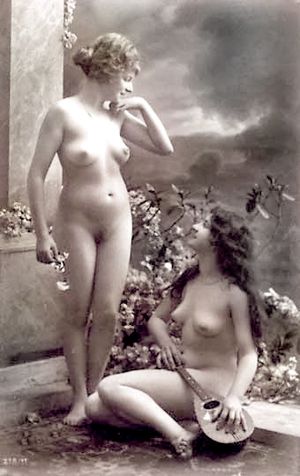Tableau vivant
Tableau vivant (plural: tableaux vivants) is French for "living picture." The term describes a striking group of suitably costumed (or nude) actors or artist's models, carefully posed and often theatrically lit. These were often created to illustrate a scene from history or literature or to recreate the composition of a well-known painting. Throughout the duration of the display, the people shown remain perfectly still and do not speak -- as if they were figures in a picture. The approach thus marries the art forms of the stage with those of painting/photography, and as such it has been of interest to modern photographers.
Erotic tableaux vivants
The most recent hey-day of the tableau vivant was the 19th century with virtually nude tableau vivants or "poses plastiques" providing a form of erotic entertainment.
Since English stage censorship often strictly forbade actresses to move when nude or semi-nude on stage, tableaux vivants also had a place in presenting risqué entertainment at special shows. In the nineteenth century they took such titles as "Nymphs Bathing" and "Diana the Huntress" and were to be found at such places as The Hall of Rome in Great Windmill Street, London. Other notorious venues were the Coal Hole in the Strand and The Cyder Cellar in Maiden Lane. The London Windmill Theatre, too, gained notoriety for featuring nude tableaux, as a way of avoiding laws forbidding girls dancing or otherwise moving whilst in a state of undress.
Tableaux vivants in spanking art
In the Victorian spanking novel "Frank" and I, set in the 1880s, the narrator and protagonist Charles Beaumont visits an elegant, upperclass flagellatory brothel in Kensington where he watches a selection of erotic tableaux vivants, including two pieces that depict a spanking/whipping scene.
In the film version, Lady Libertine, the tableaux vivants scene is featured as well, but the presentations are not real tableaux vivants because the models move.
The creation and design of a tableu vivant is similar to the creation of a scene in fine art photography and in rendered art, where the artist's task is also to create a three-dimensional staged setting, with props, lighting, and skillfully posed clothed or nude figures.
- More information is available at [ Wikipedia:Tableau_vivant ]
Chat rooms • What links here • Copyright info • Contact information • Category:Root
